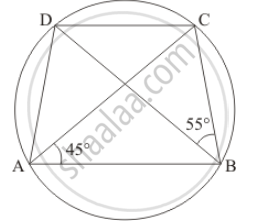Advertisements
Advertisements
Question
If diagonals of a cyclic quadrilateral are diameters of the circle through the vertices of the quadrilateral, prove that it is a rectangle.
Solution

Let ABCD be a cyclic quadrilateral having diagonals BD and AC, intersecting each other at point O.
∠BAD = `1/2angleBOD`
= `180^@/2`
= 90° ...(Consider BD as a chord)
∠BCD + ∠BAD = 180° ...(Cyclic quadrilateral)
∠BCD = 180° − 90° = 90°
∠ADC = `1/2angleAOC`
= `1/2(180^@)`
= 90° ...(Considering AC as a chord)
∠ADC + ∠ABC = 180° ...(Cyclic quadrilateral)
90° + ∠ABC = 180°
∠ABC = 90°
Each interior angle of a cyclic quadrilateral is of 90°. Hence, it is a rectangle.
APPEARS IN
RELATED QUESTIONS
A chord of a circle is equal to the radius of the circle. Find the angle subtended by the chord at a point on the minor arc and also at a point on the major arc.
If circles are drawn taking two sides of a triangle as diameters, prove that the point of intersection of these circles lie on the third side.
Prove that the line of centres of two intersecting circles subtends equal angles at the two points of intersection.
Let the vertex of an angle ABC be located outside a circle and let the sides of the angle intersect equal chords AD and CE with the circle. Prove that ∠ABC is equal to half the difference of the angles subtended by the chords AC and DE at the centre.
Prove that the circle drawn with any side of a rhombus as diameter passes through the point of intersection of its diagonals.
Bisectors of angles A, B and C of a triangle ABC intersect its circumcircle at D, E and F respectively. Prove that the angles of the triangle DEF are `90^@-1/2A, 90^@-1/2B" and "90^@-1/2C`
Circles are described on the sides of a triangle as diameters. Prove that the circles on any two sides intersect each other on the third side (or third side produced).
In the given figure, ABCD is a cyclic quadrilateral in which AC and BD are its diagonals. If ∠DBC = 55° and ∠BAC = 45°, find ∠BCD.
In a cyclic quadrilaterals ABCD, ∠A = 4x, ∠C = 2x the value of x is
If bisectors of opposite angles of a cyclic quadrilateral ABCD intersect the circle, circumscribing it at the points P and Q, prove that PQ is a diameter of the circle.
